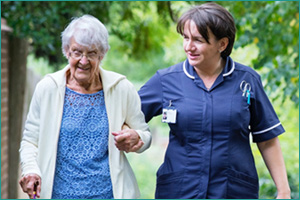Speak up!
If you've written a blog, wish to share a story, or have an idea that you believe would help those visiting the End With Care website, please send it along. If fitting, we'll add your voice to End With Care.
I've got an ideaConsidering the Choice to Die at Home
Posted on November 7, 2021
 Literally for centuries in the US, end of life care was usually given by families, loved ones, or others in the community. For most Americans, death and dying happened at home.
Literally for centuries in the US, end of life care was usually given by families, loved ones, or others in the community. For most Americans, death and dying happened at home.
But starting in the 1960s and 70s, what once was the most common place to die, gave way to a variety of other options. Advances in medical care coupled with more hospitals providing intensive care facilities, the rise in residential nursing facilities, and the beginnings of hospice care, led not only to changes in how we die, but also where we die. Instead of dying at home, people approached the final stage of life, more often in hospitals and in nursing homes.
But recent surveys have indicated the vast majority of those polled would prefer to die at home. Other studies have shown that from the early 2000s, in hospital and nursing facilities natural deaths have been decreasing and deaths at home have increased. These finding reflect progress toward having the kind of end of life that most people say they want and suggest a shift back to what was once the norm.
Planning is Vital
Dying at home or providing care for someone dying at home can be a very meaningful and rewarding experience. In addition to the individual’s own wellbeing, family and friends may find comfort by being involved and providing much of the care. Unlike dying in a hospital, hospice, or residential nursing facility, dying at home can present additional physical, emotional, and financial challenges and will require thoughtful planning and support.
Your Support Team
 A key component when considering a death at home is to make sure that you have assembled a support team to help you develop a plan and help deliver care. Understanding that nurses or aides may not actually take up the bulk of caregiving responsibilities, it’s important to find the right team to care for the dying person. Your support network might include your family doctors and nurse practitioners, hospice and palliative care providers, home care nurses, and healthcare aides. You may also seek support from other family and friends or members of your religious or faith-based community. Your team can assist with available resources you need now, what may be needed in the future, as well as provide the reassurance that no one has to cope alone. For additional information, see our blogs: Hospice Care, Comfort Care, & Palliative Care and An Introduction to Home Care Services.
A key component when considering a death at home is to make sure that you have assembled a support team to help you develop a plan and help deliver care. Understanding that nurses or aides may not actually take up the bulk of caregiving responsibilities, it’s important to find the right team to care for the dying person. Your support network might include your family doctors and nurse practitioners, hospice and palliative care providers, home care nurses, and healthcare aides. You may also seek support from other family and friends or members of your religious or faith-based community. Your team can assist with available resources you need now, what may be needed in the future, as well as provide the reassurance that no one has to cope alone. For additional information, see our blogs: Hospice Care, Comfort Care, & Palliative Care and An Introduction to Home Care Services.
An End-of-Life Environment
Choosing to die at home can help the dying maintain their emotional health, by being surrounded by a familiar setting and familiar faces who can freely come and go. Being at home also allows for a greater sense of autonomy  and control over daily activities, visitors, and the general environment. Check with your doctor, support team, or other resources for making adjustments to your home to create a comfortable and functional environment. One will likely need to arrange for services or special equipment, like a hospital bed, wheelchair, walker, bath seat, shower rail, bedside commode, or oxygen tanks.
and control over daily activities, visitors, and the general environment. Check with your doctor, support team, or other resources for making adjustments to your home to create a comfortable and functional environment. One will likely need to arrange for services or special equipment, like a hospital bed, wheelchair, walker, bath seat, shower rail, bedside commode, or oxygen tanks.
Being Prepared
Caring for a loved one who is dying can be a deeply fulfilling and special experience, but it can also be traumatic for one who has never accompanied someone at the end of life before. While it is important to follow the doctor's plan for care, treatments, and medications to help make the dying person as comfortable as possible, it is essential that anyone who has agreed to care for their loved one while they are dying understands what lies ahead of them.
one who has never accompanied someone at the end of life before. While it is important to follow the doctor's plan for care, treatments, and medications to help make the dying person as comfortable as possible, it is essential that anyone who has agreed to care for their loved one while they are dying understands what lies ahead of them.
The dying generally experience changes as their illness advances and over time they may develop new or progressing symptoms like; shortness of breath, confusion, the inability to swallow, loss of appetite, or losing consciousness. Understanding the signs and symptoms of dying can help one prepare to accompany a loved one through their end-of-life process. See our blog: Signs and Symptoms at the End of Life.
The end of life does not need to be painful, and no one should die with uncontrolled pain. According to the American Alliance of Cancer Pain Initiatives, thanks to modern medicine, about 90-95% of all dying patients should be able to experience significant relief from pain. Having a better understanding of pain and how to treat it can help create a more comfortable and gentle dying process for the patient and their family members. For more information, see our blog: Managing Pain at the End of Life.
The following resources can also help the dying and their loved ones better prepare for the end of life.
- Living with Dying: A Complete Guide for Caregivers
- Dying at Home: A Family Guide for Caregiving by Andrea Sankar
- Being Mortal by Atul Gawande
- Take Care: AARP Resources for Caregivers
Choosing Where to Die
We don’t always have a say in where we wish to die, but considering your care at the end of life can help ensure that you  have a dignified death. Whether at home, in a hospital, hospice environment, or a residential nursing facility, being in the place that feels right for you and having some control in that decision can be comforting to you and your loved ones.
have a dignified death. Whether at home, in a hospital, hospice environment, or a residential nursing facility, being in the place that feels right for you and having some control in that decision can be comforting to you and your loved ones.
Making the choice of where you’d prefer to die is a very personal decision. There is no absolute right answer, but there are a number of things to consider and priorities to weigh to help you determine what is best for you. For more information about the choices available and choosing what might be right for your situation, we invite you to view our free webinar: Where Do You Want To Die - Choosing The Option That's Right For You.


